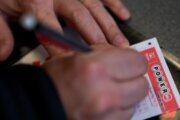As decades of research and public health messaging attest, the breathtaking lack of exercise we get as a society has become a matter of life and death. A lack of fitness currently lags behind only smoking as a risk factor for predicting if a person will die early. A sedentary life raises a person’s risk of developing everything from diabetes and heart disease to colon cancer and breast cancer. Yet, for the tidal wave of health problems that can sweep up people who don’t get a move on, it’s still commonplace in medical visits for health providers to make no more than a passing comment about physical activity to patients — if exercise is discussed at all.
Despite our lack of physical activity and cardio fitness — and sedentary lifestyles being “strongly associated with the emerging epidemic of chronic disease” — upwards of 9 in 10 American adults may not meet physical activity guidelines, notes a paper published this spring in a review journal of the American College of Sports Medicine. Those recommendations include getting 150 minutes per week of moderate intensity exercise, like brisk walking, and there’s reason to exercise more. The paper highlights a call by the ACSM and Oakland, California-based health care giant Kaiser Permanente to make assessing and prescribing physical activity a standard part of care, including implementing a physical activity vital sign that would be routinely checked and recorded at every medical visit.
In assessing exercise as a vital sign, doctors at Kaiser ask patients a couple basic questions to fill out their electronic medical records: namely, how many days per week they do at least moderate to strenuous exercise, like taking a brisk walk, and the average amount of minutes per day they exercise at this level. It’s not unlike asking a patient about smoking status, which providers record in a medical record, and it gives providers an opportunity to begin a discussion about the importance of activity to improve health. “Patients who are active and fit live longer, healthier, better lives,” says Dr. Robert Sallis, family and sports medicine physician and co-director of the sports medicine fellowship at the Kaiser Permanente Medical Center in Fontana, California. “They’re much less likely to suffer from chronic disease — we’ve just got study after study proving that. Yet we hardly pay attention to it in organized medicine.” Kaiser became the first major health organization in the country to incorporate exercise as a vital sign when it began phasing in the approach at its medical centers in 2009.
Questions remain regarding the most reliable way to measure physical activity — whether asking patients or, perhaps in the future, relying more on activity tracking devices. Given doctors’ limited time and the lack of formal medical education devoted to exercise, there’s ongoing discussion about how physicians could best discuss physical activity-related concerns with patients and when to refer patients, such as for physical therapy, exercise classes or even rehab in more extreme circumstances. But more providers are already incorporating assessing physical activity as a vital sign to increase the focus on the all-important lifestyle factor.
[See: 7 Exercises You Can Do Now to Save Your Knees Later.]
Salt Lake City-based Intermountain Healthcare began assessing physical activity as a vital sign in adult patients in 2013, and has more recently instituted the use of a pediatric physical activity vital sign as well. And in October, Greenville Health System in South Carolina announced it was partnering with the University of South Carolina School of Medicine Greenville, the YMCA of Greenville and the ACSM to not only prescribe exercise to patients but to track physical activity as a vital sign. The Exercise is Medicine Greenville program is part of a U.S.-based, global Exercise is Medicine initiative first launched in 2007 by the American Medical Association and the ACSM, which manages the initiative that encourages primary care providers and other clinicians to include physical activity in designing their treatment plans.
Though still not common practice, other health systems are also in the process of implementing a physical activity vital sign, or a PAVS, says Adrian Hutber, vice president for Exercise is Medicine at the American College of Sports Medicine. “I think it’s universally true that health care systems across the country are beginning to recognize the importance of lifestyle medicine,” he says, including focusing on physical activity and nutrition. As health care costs continue to spiral out of control, the Centers for Medicare and Medicaid Services is moving toward reimbursing based on patient outcomes — rather than simply the volume of procedures or services performed — and checking to see whether doctors are discussing physical activity and encouraging exercise with older patients.
[See: 8 Signs You Are Made to Be an Athlete.]
Given that the use of a PAVS is still in its infancy, there’s limited research on how effective treating exercise as a vital sign may be in changing a person’s behavior and health outcomes. However, one 2013 study published in the Journal of General Internal Medicine evaluating Kaiser’s program found implementation of exercise as a vital sign was associated with patients making more progress in increasing exercise levels, as compared with patients seen at medical centers where exercise wasn’t assessed as a vital sign. In addition, patients who were overweight lost slightly more weight — though just a fraction of a pound more, on average, during the 16-month study period — and those with diabetes had greater success lowering A1C levels, a marker of average blood sugar. While the measured effect was modest, researchers say the differences were still significant and that the findings support a care model that would include routinely collecting patient-reported exercise data.
Information patients report on their activity levels is also being used to predict possible outcomes and guide treatment. For example, Kaiser’s own research found that patients with end-stage or very severe COPD who reported doing zero exercise had a 40 percent higher chance of being readmitted to the hospital within a month, Sallis notes, compared with those who reported even a little bit of activity. “So it’s caused us to shift our care of those COPD patients to making sure we’re talking to them about the importance of being physically active,” he says.
For the vast majority of patients who go to health providers that don’t assess physical activity as a vital sign, experts advise being proactive about discussing activity levels in the context of prevention and treatment. Anthony Marsh, a professor of health and exercise science at Wake Forest University in Winstom-Salem, North Carolina, points out that research finds when individuals — especially older adults — increase activity levels, they often reduce the medications they’re taking. “It’s remarkable the changes that can occur if a person begins a program of regular physical activity,” he says.
[See: 10 Ways to Live Healthier and Save Money Doing It.]
Before accepting a new prescription or treatment, experts advise patients ask their doctors if they might try physical activity as an alternative first. “I think that all patients, when a doctor tells them they want to put them on medication, they [should ask the] question, ‘Would exercise help this?'” Sallis advises. For example, he says, those with high blood sugar might ask if they could first try making dietary changes and exercising to see if that would make enough difference to prevent the need for going on insulin. “I think all physicians need to assess the impact of physical activity on their patient’s health and encourage them to be active.”
More from U.S. News
Exercising After You’ve Gone Under (the Knife, That Is)
7 Signs You Should Stop Exercising Immediately
10 Lessons From Empowered Patients
Treating Exercise As a Vital Sign originally appeared on usnews.com







